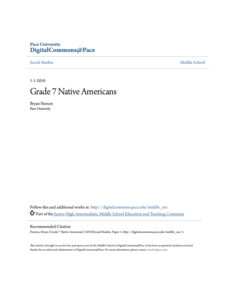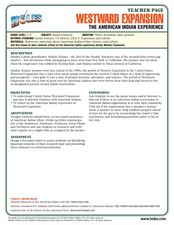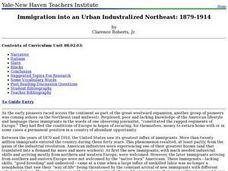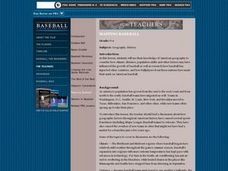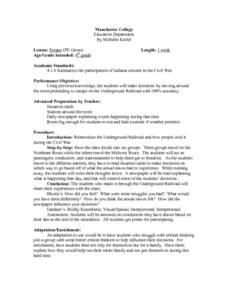Pace University
Native Americans
Introduce middle schoolers to the First Nations that inhabited the Northeast during the Age of Exploration with a series of activities designed for differentiated groups.
Northeast Georgia Regional Educational Service Agency
The American Revolution
An empowering lesson explores the causes and complaints that led to the American Revolution. Young scholars, starting in fourth grade, complete hands-on activities, role play, and create cartoons to understand the American Revolution and...
Smithsonian Institution
African American Music: Let’s Sing and Play Clapping Games
Two lessons focus on making a beat. Using popular African American music of its time, scholars listen and analyze the rhythm then recreate it with hands drums, and cups.
National Park Service
How Theodore Roosevelt Became a Leader: Childhood of an American President
The beginning of the 20th century began with a shock: the assassination of President McKinley. The man who would take his place—the youngest American to ever become president—led quite a life before stepping foot in the Oval Office. An...
Curated OER
Native American Indians: Wampanoags
Students understand the contributions of the Native American tribes. In this Native American lesson, recognize Native American names, words and cultures. Students understand that different tribes lived in different parts of the country....
Curated OER
The Power of Maps & Native American Cultures
Sixth graders discover where and how five Native American cultures lived in North America in what is currently the United States. They examine their way of life and the regions they inhabited. Additionally, 6th graders will understand...
Curated OER
Westward Expansion: The American Indian Experience
Students complete a brief presentation documenting the life of an American Indian. In class, students discuss the pros and cons of placing American Indians on a reservation. After their discussion, students choose a issue in Native...
Scholastic
Owl Moon Teaching Plan
Capture the engagement of young readers with this collection of activities based on Jane Yolen's book, Owl Moon. Following a shared reading of this children's story, the class explores the geography of the American Northeast,...
Curated OER
Where, Oh Where
Students use maps to explore several traditional regions of Native Americans. They research information on the regions' climate, resources, landforms, flora and fauna.
Curated OER
Immigration into an Urban Industralized Northeast: 1879-1914
Students study how three ethnic groups were introduced to urban, industrialize, northern cities. They examine how these groups were greeted and accepted be the 'native born' Americans and how successful they were in assimilating with...
Curated OER
Native American Project
Students explore the influences that geography has on a Native American tribe's culture and lifestyle. They examine how the first encounters with Europeans affected that tribe.
Curated OER
Native American Dwellings Scavenger Hunt
In this social studies learning exercise, students work on a project to find information about the dwellings of Native Americans for the seven questions while using the internet.
Curated OER
The Seasons of Thanks
First graders explain the Native American cyclical concept of time
Curated OER
Searching the Net
Learners create a Native American Nation flip book. In this Native American lesson, students choose one of four Native American Nations: The Iroquois, Hopi, Seminoles, Sioux. They research them on the Internet using teacher given...
Curated OER
How Connecticut Benefited from American Slavery
Eleventh graders explore Connecticut slavery. In this American slavery lesson, 11th graders analyze primary sources relating to slavery in the state as they research in collaborative groups. Students determine whether Connecticut...
Curated OER
Fort Life in the Green Bay Area, 1816-1841
Ninth graders examine from the perspectives of military personnel, Native Americans, families of soldiers, and civilians who lived and worked in the region during the era. They create a 2-page scrapbook layout from at least two of the...
Curated OER
A-maizing Facts
Students research the lives of Native Americans living in the Northeast Woodlands region, focusing on how the climate, location, and physical surroundings affected their way of life.
Curated OER
The Geography of the United States
Full of bright maps and interesting information, this presentation details U.S. Geography. Slides include basic facts about size, regions, topography, and demographics, as well as fascinating trivia about the United States, including...
Curated OER
Sectionalism in Early U.S.
Learners, divided into three groups, representing the Northeastern, Southern, Western United States. They research these areas in early American history and as a group prepare charts, graphs and reports. They explain their needs and...
Curated OER
Chapter 3 – Antebellum Innovation, Politics, and the Jackson Administration
The inter-war Antebellum Era was a fascinating time in U.S. History! In this textbook response worksheet, historians read assigned textbook pages regarding the topics and respond to 46 short answer display questions regarding the...
Curated OER
Chapter 10: "Currents of Change in the Northeast and the Old Northwest" Chapter 11: "Slavery and the Old South"
Students use the indicated text and the internet to compare and contrast the North and South. They discuss the social and political implications of the two predominant economic systems (slavery and factory). They are introduced to the...
Curated OER
Mapping Baseball
Students research how climate, distance, population shifts and immigration have influenced American baseball. They also consider how players from other countries have made their mark on American baseball.
Curated OER
Cinderella Trilogy
Learners look at three different versions of the Cinderella story. In this comparative literature lesson, students read the Chinese version "Yeh-Shen", the Egyptian version "Rhodopis," and the Native American version "The Hidden One" of...
Curated OER
Escape - Civil War
Fourth graders role play the Underground Railroad in this instructional activity. They review the Underground Railroad and how people used it during the Civil War. They then are divided into groups, and role play with each group taking...


